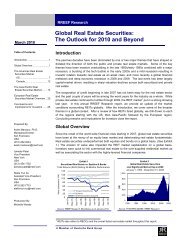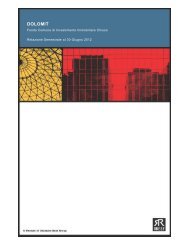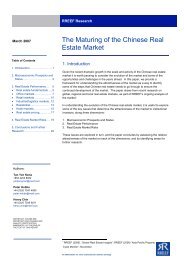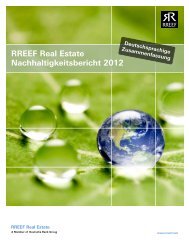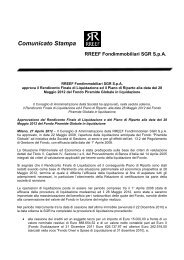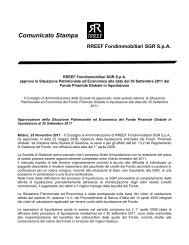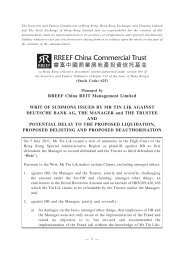Infrastructure Investments in Renewable Energy - RREEF Real Estate
Infrastructure Investments in Renewable Energy - RREEF Real Estate
Infrastructure Investments in Renewable Energy - RREEF Real Estate
Create successful ePaper yourself
Turn your PDF publications into a flip-book with our unique Google optimized e-Paper software.
support the development of renewable-energy sources. Currently, governments use three<br />
ma<strong>in</strong> sets of regulatory tools to address climate change and the need for alternative sources of<br />
energy: 1) carbon pric<strong>in</strong>g 2) traditional regulation (mandates and standards) and 3) <strong>in</strong>novation<br />
policy (<strong>in</strong>centives and subsidies). 12 Among the three broad categories, we believe that carbon<br />
pric<strong>in</strong>g, used to <strong>in</strong>ternalize the external variable of climate change, is the most effective longterm<br />
policy. While traditional regulation corrects market failures and <strong>in</strong>novation policy can<br />
<strong>in</strong>centivize the development of new technologies, neither of those regulatory tools effectively<br />
prices the long-term externality associated with greenhouse gas emissions. 13<br />
Macroeconomic Trends<br />
As scientific evidence becomes more conclusive, policy makers globally are <strong>in</strong>creas<strong>in</strong>gly<br />
focused on the hazards of climate change and the need to develop non-exhaustible,<br />
susta<strong>in</strong>able, sources of energy. Alternative sources of energy which are typically carbon free<br />
have ga<strong>in</strong>ed prom<strong>in</strong>ence as a solution. As mentioned <strong>in</strong> the <strong>in</strong>troduction, such alternatives are<br />
renewable sources of energy generated from natural resources, <strong>in</strong>clud<strong>in</strong>g hydro, solar<br />
(photovoltaic and thermal), w<strong>in</strong>d, geothermal, tidal, biofuels, and waste-to-energy processes.<br />
This is <strong>in</strong> contrast to conventional sources of energy such as oil, gas, coal, and <strong>in</strong> some cases,<br />
nuclear. The majority of conventional sources of energy is “exhaustible” and will lead to<br />
greenhouse gases such as CO2 and methane as depicted <strong>in</strong> Exhibit 2.<br />
Analysts view today’s renewable energy <strong>in</strong>dustry as almost a guaranteed-growth sector,<br />
supported by three underly<strong>in</strong>g global mega-trends. These dynamic drivers <strong>in</strong>clude:<br />
1. More str<strong>in</strong>gent climate change agendas<br />
2. Dw<strong>in</strong>dl<strong>in</strong>g fossil fuel stocks<br />
3. Heightened concerns over the security of energy supplies<br />
These drivers rema<strong>in</strong> valid<br />
today and have been<br />
responsible for the growth<br />
of the renewables market to<br />
$120 billion <strong>in</strong> 2008, despite<br />
the unfold<strong>in</strong>g of a major<br />
f<strong>in</strong>ancial crisis (see Exhibit<br />
4). High oil and natural gas<br />
prices <strong>in</strong> 2007 and 2008<br />
were a secondary factor,<br />
driv<strong>in</strong>g up <strong>in</strong>vestments <strong>in</strong><br />
renewables dur<strong>in</strong>g this<br />
period. Security concerns<br />
Exhibit 4<br />
Global Investment <strong>in</strong> <strong>Renewable</strong> <strong>Energy</strong>, 2004-2008*<br />
140<br />
120<br />
100<br />
80<br />
60<br />
40<br />
20<br />
0<br />
2004 2005 2006 2007 2008<br />
about energy supplies cont<strong>in</strong>ue to <strong>in</strong>tensify. Over 70% of the world’s oil reserves are held <strong>in</strong><br />
regions with significant geopolitical risk. This should drive oil-import<strong>in</strong>g countries to lower their<br />
dependence on oil by diversify<strong>in</strong>g <strong>in</strong>to domestic sources of renewable energy.<br />
Major shifts <strong>in</strong> the global economy and f<strong>in</strong>ancial landscape have impacted the renewables<br />
sector more recently, however. The decl<strong>in</strong>e <strong>in</strong> oil prices <strong>in</strong> the second half of 2008 and early<br />
2009 has curtailed <strong>in</strong>vestment activity <strong>in</strong> the sector. <strong>Renewable</strong>s have not been immune to the<br />
impact of the f<strong>in</strong>ancial crisis either, as a variety of f<strong>in</strong>anc<strong>in</strong>g sources have dried up.<br />
12<br />
DB Advisors, “Invest<strong>in</strong>g <strong>in</strong> Climate Change 2009 – Necessity and Opportunity <strong>in</strong> Turbulent Times”, Deutsche<br />
Bank Group, October 2008<br />
13<br />
DB Advisors, “Invest<strong>in</strong>g <strong>in</strong> Climate Change 2009 – Necessity and Opportunity <strong>in</strong> Turbulent Times”, Deutsche<br />
Bank Group, October 2008<br />
Alternative <strong>Investments</strong> 5<br />
US$ Billions<br />
*Figure <strong>in</strong>cludes project f<strong>in</strong>ance and non-project f<strong>in</strong>ance deals<br />
Source: REN 21.2009. <strong>Renewable</strong>s Global Status Report: 2009 Update (Paris: REN 21 Secretariat)





